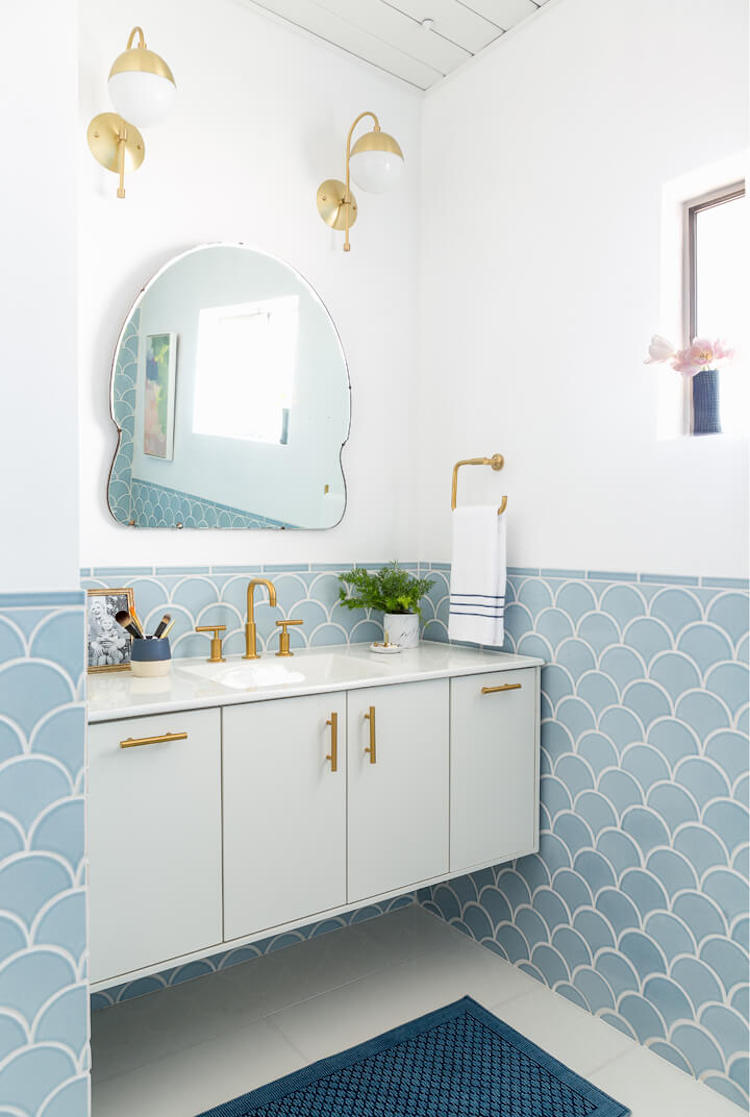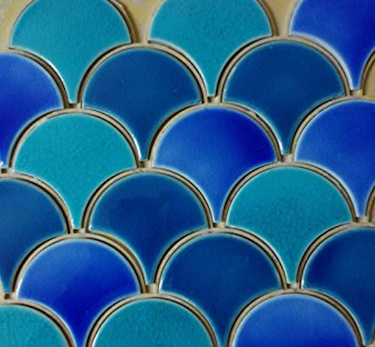In today’s post, I’m going to dive into one of the hottest new bathroom tile trends – fish scale tiles, also known as scallop tiles. This unique tile style adds eye-catching texture and dimension to any bathroom. Scallop tiles get their name from their curved, overlapping scale-like shape that mimics the scales of a fish or seashell.
While fish scale tiles have been around for centuries and can be traced back to ancient Roman and Greek architecture, they are currently experiencing a major resurgence in popularity for modern bathroom designs.
The contemporary iterations of scallop tiles now come in a vast array of colors, materials, sizes and finishes, making them extremely versatile for all different styles. Whether you’re looking to create a coastal aesthetic with shades of blue, go for an earthy vibe with terra cotta, or achieve a modern spa-like look in white, there are endless possibilities with fish scale tiles.
Stay tuned as we dive into the history of this regal tile, explore popular options and styles available today, and take a look at some gorgeous scallop tile bathroom designs and ideas!
Fish Scale Tile Layout
Do fish scale tiles go up or down? Fish scale tiles are typically installed in a downward orientation, with the curved edges of the tiles pointing downwards. There are a few reasons for this standard installation method:
- Aesthetics – The downward orientation mimics real fish scales and creates a flowing, rippling visual effect on the wall. Installing the tiles upward would disrupt this look.
- Functionality – The overlapping and curved nature of the tiles allows water to easily run down the wall when installed in a downward direction. Water would not shed as efficiently if the tiles pointed upwards.
- Tradition – Historically, in locations like ancient Rome where fish scale tiles originated, they were always oriented downwards. The traditional look has stuck over time.
- Weight – With the curves pointing down, the tiles support each other and gravity helps hold them in place. reversing them could cause issues over time.
However, there are no hard rules and some designers do choose to install fish scale tiles in an upward direction for a unique look. But the standard practice is pointing the curved edges of the tiles downwards for both practical and aesthetic reasons.
Where to Use Scallop Tiles in the Bathroom
Here are some of the best places to install scallop tiles in a bathroom:
- Shower Walls – Scallop tiles are most commonly used on shower walls, either floor to ceiling or as a decorative focal point. The curves and texture make for an eye-catching shower backdrop.
- Backsplash – Using scallop tiles for a vanity or tub backsplash adds subtle interest and works nicely with standard wall tiles. A row of scallops along the wall is a great way to incorporate the tiles without overdoing it.
- Accent Strips – Thin strips of scallop tiles can be used along walls, showers, or backsplashes as accents. This can be a nice way to integrate the tiles into a space with other styles.
- Floor – While less common, using scallop tiles on a bathroom floor can make a bold statement. Make sure they are slip-resistant. Smaller scallops work best to avoid an uneven surface.
- Tile Risers – For stair-stepped or elevated parts of a bathroom, scallop tiles can be used to tile the risers.
The key is choosing the right scale and amount of fish scale tiles to complement the overall space. Used thoughtfully, they can add a touch of elegance!
Scallop Tiles We Love
Have you used scallop tiling in your bathroom or home?







Maybe I’m missing it- but where did she order the tile from? I’m looking for this tile and finding it difficult to find.
Thank you
Could you tell me the brand for the light blue scallopped tile. I would like to buy this tile.
.
Same! Could you please share where the light blue scalloped tile is from. Thank you!
Hi! Emily used Fireclay Tile Ogee Drop.